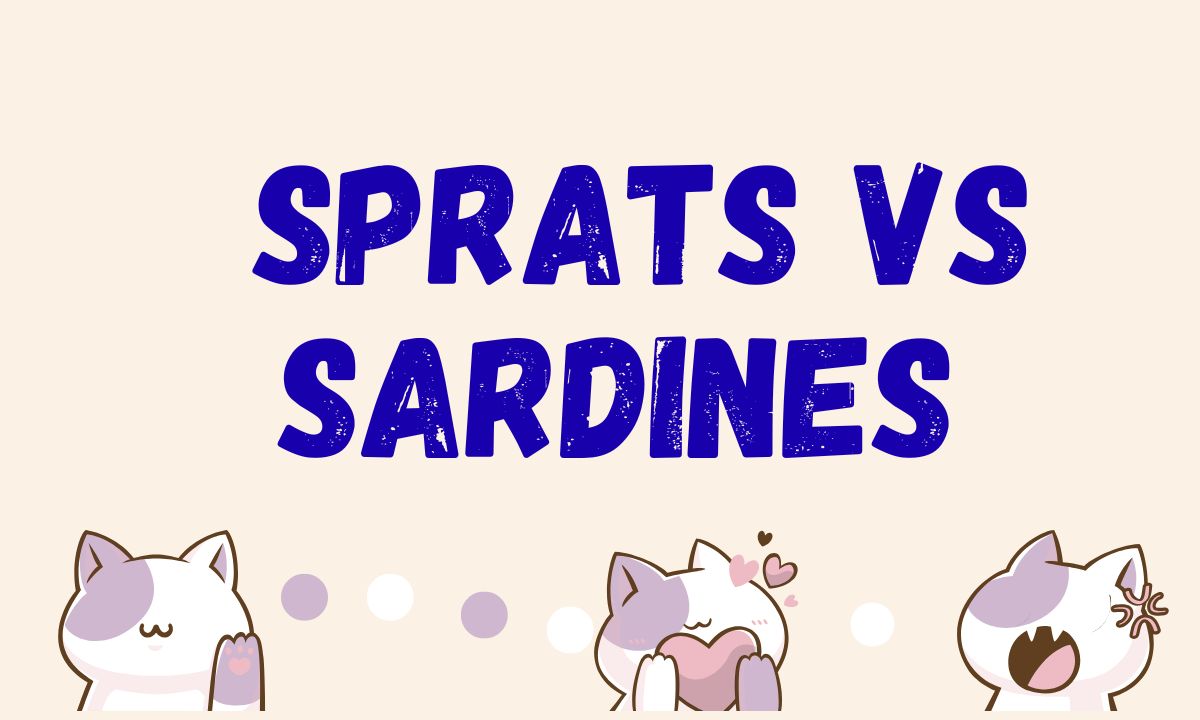When you walk down the canned fish aisle, you’ll often spot sprats and sardines side by side. Both are small, oily fish, packed with flavor and nutrients, yet they’re not the same. Many people confuse them because of their similar size and taste, but sprats vs sardines is more than just a naming difference it’s about species, flavor, texture, and even how they’re used in cooking.
In this article, we’ll break down everything you need to know about sprats and sardines, from their biology and nutritional benefits to their culinary uses and global popularity. Let’s dive in and uncover which fish deserves a spot on your plate.
Understanding Sprats and Sardines
Sprats and sardines both belong to the Clupeidae family, which also includes herring and anchovies. However, they are different species within this family.
Sprats are smaller, silver-colored fish, typically measuring 8–12 cm long. They are often called bristling in some regions, especially around the Baltic Sea. Sprats are soft, delicate, and rich in omega-3 fatty acids, giving them a strong but pleasant flavor.
Sardines, on the other hand, are slightly larger, averaging around 15–20 cm in length. They are also known as pilchards in some parts of the world. Sardines are meatier, have a milder flavor, and are often preserved in oil, tomato sauce, or brine.
While they share similarities in nutrition and appearance, the texture and taste make them quite different in cooking and eating experiences.
Sprats: Definition and Characteristics
Sprats are small, oily fish belonging to the genus Sprattus. The most common species is the European sprat (Sprattus sprattus), found in the Baltic and North Seas.
These fish have shiny silver bodies and soft flesh, making them easy to eat whole bones and all. Sprats are often smoked, salted, or canned, especially in Eastern Europe and Scandinavia. In countries like Latvia, Estonia, and Russia, smoked sprats are a popular delicacy often served on bread with butter or eggs.
Sprats have a bold and salty flavor that pairs perfectly with rich or creamy foods. Their small size and tender bones make them a convenient and tasty snack, especially when smoked or fried.
Nutritionally, sprats are packed with omega-3 fatty acids, vitamin D, and calcium, supporting heart and bone health. Because you usually eat the entire fish, they offer more minerals compared to filleted options.
Sardines: Definition and Characteristics
Sardines, belonging to the genus Sardina or Sardinops, are slightly larger than sprats and have a thicker, meatier texture. The most well-known species is the European sardine (Sardina pilchardus), found in the Mediterranean Sea and Atlantic Ocean.
Sardines gained global popularity as a nutrient-rich, affordable food. They are commonly sold canned in oil, water, or sauce, but fresh sardines are also grilled or baked in Mediterranean cuisine.
Compared to sprats, sardines have a milder flavor and firmer texture. This makes them versatile for salads, pasta, or sandwiches. Nutritionally, sardines are rich in protein, omega-3 fatty acids, vitamin B12, and calcium a complete source of essential nutrients for muscle, brain, and bone health.
Their nutritional value and long shelf life make sardines a staple in many diets worldwide, especially among people seeking healthy and sustainable seafood options.
Sprats vs Sardines: Key Differences
Here’s a side-by-side comparison that highlights the main distinctions between sprats and sardines:
| Feature | Sprats | Sardines |
|---|---|---|
| Scientific Genus | Sprattus | Sardina / Sardinops |
| Size | 8–12 cm | 15–20 cm |
| Flavor | Stronger, saltier | Milder, less intense |
| Texture | Soft and delicate | Firm and meaty |
| Common Preparation | Smoked, canned, fried | Canned, grilled, baked |
| Geographic Origin | Northern Europe | Mediterranean and Atlantic regions |
| Nutritional Focus | High in calcium and omega-3 | Rich in protein and vitamin B12 |
| Best For | Snacks, spreads, appetizers | Salads, pasta, sandwiches |
This table shows that while both fish are nutritious and versatile, their taste and texture cater to different culinary preferences.
Nutritional Comparison: Which Is Healthier?
Both sprats and sardines are excellent sources of omega-3 fatty acids, known for supporting heart health, reducing inflammation, and improving brain function. However, sardines usually contain slightly more protein, while sprats have higher calcium levels because the entire fish is often consumed.
A 100-gram serving typically provides:
- Sprats: ~180 calories, 10g fat, 22g protein
- Sardines: ~200 calories, 11g fat, 25g protein
Both fish are low in carbohydrates, making them ideal for low-carb or keto diets. Additionally, they’re rich in vitamin D, iron, and selenium, helping support overall well-being.
Taste and Culinary Uses
When it comes to flavor, sprats are more intense and salty, while sardines are milder and meatier. Sprats are popular in Eastern European cuisines especially in smoked form where they’re served on dark rye bread with mustard or eggs.
Sardines, on the other hand, are commonly used in Mediterranean dishes. Fresh sardines can be grilled with olive oil and lemon, while canned versions are often added to pasta or salads.
Here are some common dishes for each:
Sprats:
- Smoked sprats on toast
- Baltic sprat sandwich
- Fried sprats with lemon and herbs
Sardines:
- Sardine pasta with olive oil and garlic
- Grilled sardines with sea salt
- Sardine salad with tomatoes and capers
Price and Availability
Both sprats and sardines are affordable sources of seafood protein, but availability depends on where you live. Sardines are more widely distributed and exported globally, while sprats are more common in northern and eastern Europe.
Canned sardines can be found in nearly any supermarket, often sold in olive oil or tomato sauce. Sprats, especially smoked ones, are more of a specialty item, usually imported from the Baltic region.
Environmental and Sustainability Factors
Both fish are sustainably caught, especially when compared to larger species like tuna or salmon. They reproduce quickly, keeping their populations stable. The Marine Stewardship Council (MSC) certifies many sardine and sprat fisheries, making them eco-friendly seafood options.
Additionally, since both fish are small and low on the food chain, they contain minimal mercury levels, making them safe for regular consumption.
Which One Should You Choose?
Your choice between sprats vs sardines depends on taste preference and usage. If you enjoy bold, smoky flavors, go for sprats. They’re ideal for appetizers and spreads. If you prefer milder, more versatile fish for everyday meals, sardines are your best bet.
Both offer impressive health benefits, affordable prices, and eco-friendly qualities. Including either in your diet once or twice a week can support heart, bone, and brain health while adding variety to your meals.
FAQs About Sprats vs Sardines
Are sprats the same as sardines?
No. Though both belong to the same fish family (Clupeidae), they are different species. Sprats are smaller and stronger in flavor, while sardines are larger and milder.
Which has more omega-3: sprats or sardines?
Both are rich in omega-3 fatty acids, but sardines slightly lead in total omega-3 content.
Can you substitute sardines for sprats in recipes?
Yes, but expect a difference in taste. Sardines will be less salty and meatier compared to sprats’ rich, smoky flavor.
Are sprats and sardines safe to eat every day?
Yes, in moderation. They are low in mercury and high in essential nutrients, making them healthy for regular consumption.
Conclusion of Sprats vs Sardines
In the Sprats vs Sardines debate, there’s no absolute winner only a matter of taste and preference. Sprats deliver a strong, smoky bite and shine in Eastern European snacks, while sardines bring a balanced, meaty flavor perfect for Mediterranean dishes.
Both are nutritional powerhouses loaded with omega-3s, vitamins, and minerals. Whether you choose sprats for their boldness or sardines for their versatility, you’re adding a delicious and healthy option to your diet. So next time you’re shopping for canned fish, remember: both sprats and sardines deserve a spot in your pantry just pick the one that fits your flavor mood best.








